Synthesis and Exploration of the Lubricating Behavior of Nanoparticulated Mo15S19 in Linseed Oil
Abstract
1. Introduction
2. Materials and Methods
2.1. Materials
2.2. Synthesis
2.3. Characterization
2.4. Rheological and Tribological Study
3. Results and Discussion
3.1. Vibrational Characterization
3.2. X-ray Powder Diffraction Analysis
3.3. SEM Analysis
3.4. SAED Pattern and TEM Images
3.5. Rheological Study
3.6. Tribological Study
3.7. Surface Analysis and Wear Mechanisms
4. Conclusions
Author Contributions
Funding
Acknowledgments
Conflicts of Interest
References
- Peña, O. Chevrel phases: Past, present and future. Phys. C Supercond. Appl. 2015, 514, 95–112. [Google Scholar] [CrossRef]
- Chevrel, R.; Hirrien, M.; Sergent, M. Superconducting Chevrel phases: Prospects and perspectives. Polyhedron 1986, 5, 87–94. [Google Scholar] [CrossRef]
- Jain, A.; Ong, S.P.; Hautier, G.; Chen, W.; Richards, W.D.; Dacek, S.; Cholia, S.; Gunter, D.; Skinner, D.; Ceder, G.; et al. Commentary: The Materials Project: A materials genome approach to accelerating materials innovation. APL Mater. 2013, 1, 011002. [Google Scholar] [CrossRef]
- Persson, K. Materials Data on Mo15S19 (SG: 176) by Materials Project. Available online: https://materialsproject.org/materials/mp-31257/ (accessed on 7 July 2018).
- Afanasiev, P. Synthetic approaches to the molybdenum sulfide materials. C. R. Chim. 2008, 11, 159–182. [Google Scholar] [CrossRef]
- Tarascon, J.M.; Hull, G.W. On several new ternary molybdenum sulfide phases M3.4Mo15S19 (M = vacancy, Li, Na, K, Zn, Cd, Sn and Tl). Mater. Res. Bull. 1986, 21, 859–869. [Google Scholar] [CrossRef]
- Tarascon, J. Electrochemical insertion of lithium and sodium in the two crystallographic forms of a new molybdenum chalcogenide phase Mo15Se19. Solid State Ionics 1986, 18–19, 768–772. [Google Scholar] [CrossRef]
- Tarascon, J.M.; Hull, G.W.; Waszczak, J.V. Synthesis, structural and physical properties of the binary molybdenum chalcogenide phase Mo15Se19 and of the related compounds M2Mo15Se19 and M3Mo15Se19 (M=group 1A metal; Sn,Pb;Cd). Mater. Res. Bull. 1985, 20, 935–946. [Google Scholar] [CrossRef]
- Macrae, C.F.; Edgington, P.R.; McCabe, P.; Pidcock, E.; Shields, G.P.; Taylor, R.; Towler, M.; van de Streek, J. Mercury: Visualization and analysis of crystal structures. J. Appl. Crystallogr. 2006, 39, 453–457. [Google Scholar] [CrossRef]
- Chevrel, R.; Sergent, M. Chemistry and structure of ternary molybdenum chalcogenides. In Superconductivity in Ternary Compounds I; Fischer, Ø., Maple, M.B., Eds.; Springer: Berlin/Heidelberg, Germany, 1982; Volume 32, pp. 25–86. [Google Scholar]
- Ramsbottom, H.D.; Hampshire, D.P. Improved critical current density and irreversibility line in HIP’ed Chevrel phase superconductor PbMo6S8. Phys. C Supercond. 1997, 274, 295–303. [Google Scholar] [CrossRef]
- Salloum, D.; Gautier, R.; Potel, M.; Gougeon, P. Mo15S20: First evidence of a new molybdenum cluster type in a metastable solid-state compound. Chem. Eur. J. 2006, 12, 8513–8517. [Google Scholar] [CrossRef] [PubMed]
- Fukuoka, H.; Masuoka, K.; Hanaoka, T.; Inumaru, K. New polymorph of Mo3S4 prepared using a high-pressure synthesis technique: Crystal structure, electronic property, and band calculation. Inorg. Chem. 2013, 52, 7918–7922. [Google Scholar] [CrossRef] [PubMed]
- Al-Jeboori, Y.; Kosarieh, S.; Morina, A.; Neville, A. Investigation of pure sliding and sliding/rolling contacts in a DLC/Cast iron system when lubricated in oils containing MoDTC-Type friction modifier. Tribol. Int. 2018, 122, 23–37. [Google Scholar] [CrossRef]
- Parenago, O.P.; Kuz’mina, G.N.; Zaimovskaya, T.A. Sulfur-containing molybdenum compounds as high-performance lubricant additives (Review). Pet. Chem. 2017, 57, 631–642. [Google Scholar] [CrossRef]
- Tang, Z.; Li, S. A review of recent developments of friction modifiers for liquid lubricants (2007–present). Curr. Opin. Solid State Mater. Sci. 2014, 18, 119–139. [Google Scholar] [CrossRef]
- Theerthagiri, J.; Senthil, R.A.; Senthilkumar, B.; Reddy Polu, A.; Madhavan, J.; Ashokkumar, M. Recent advances in MoS2 nanostructured materials for energy and environmental applications—A review. J. Solid State Chem. 2017, 252, 43–71. [Google Scholar] [CrossRef]
- Ilie, F.I.; Tita, C.M. Tribological properties of solid lubricant nanocomposite coatings obtained by magnetron sputtered of MoS2/metal (Ti, Mo) nanoparticles. Proc. Rom. Acad. Ser. A Math. Phys. Tech. Sci. Inf. Sci. 2007, 8, 1–5. [Google Scholar]
- Gulzar, M.; Masjuki, H.H.; Kalam, M.A.; Varman, M.; Zulkifli, N.W.M.; Mufti, R.A.; Zahid, R. Tribological performance of nanoparticles as lubricating oil additives. J. Nanopart. Res. 2016, 18, 223. [Google Scholar] [CrossRef]
- Shahnazar, S.; Bagheri, S.; Abd Hamid, S.B. Enhancing lubricant properties by nanoparticle additives. Int. J. Hydrog. Energy 2016, 41, 3153–3170. [Google Scholar] [CrossRef]
- Xiao, H.; Liu, S. 2D nanomaterials as lubricant additive: A review. Mater. Des. 2017, 135, 319–332. [Google Scholar] [CrossRef]
- Rasheed, A.K.; Khalid, M.; Rashmi, W.; Gupta, T.C.S.M.; Chan, A. Graphene based nanofluids and nanolubricants—Review of recent developments. Renew. Sustain. Energy Rev. 2016, 63, 346–362. [Google Scholar] [CrossRef]
- Cheng, Z.-L.; Qin, X.-X. Study on friction performance of graphene-based semi-solid grease. Chin. Chem. Lett. 2014, 25, 1305–1307. [Google Scholar] [CrossRef]
- Mura, A.; Curà, F.; Adamo, F. Evaluation of graphene grease compound as lubricant for spline couplings. Tribol. Int. 2018, 117, 162–167. [Google Scholar] [CrossRef]
- Fan, X.; Wang, L. High-performance lubricant additives based on modified graphene oxide by ionic liquids. J. Colloid Interface Sci. 2015, 452, 98–108. [Google Scholar] [CrossRef] [PubMed]
- Kamel, B.M.; Mohamed, A.; El Sherbiny, M.; Abed, K.A.; Abd-Rabou, M. Tribological properties of graphene nanosheets as an additive in calcium grease. J. Dispers. Sci. Technol. 2016, 38, 1495–1500. [Google Scholar] [CrossRef]
- Dou, X.; Koltonow, A.R.; He, X.; Jang, H.D.; Wang, Q.; Chung, Y.-W.; Huang, J. Self-dispersed crumpled graphene balls in oil for friction and wear reduction. Proc. Natl. Acad. Sci. USA 2016, 113, 1528–1533. [Google Scholar] [CrossRef] [PubMed]
- Huang, H.D.; Tu, J.P.; Gan, L.P.; Li, C.Z. An investigation on tribological properties of graphite nanosheets as oil additive. Wear 2006, 261, 140–144. [Google Scholar] [CrossRef]
- Kania, D.; Yunus, R.; Omar, R.; Abdul Rashid, S.; Mohamad Jan, B. A review of biolubricants in drilling fluids: Recent research, performance, and applications. J. Pet. Sci. Eng. 2015, 135, 177–184. [Google Scholar] [CrossRef]
- Vahur, S.; Teearu, A.; Peets, P.; Joosu, L.; Leito, I. ATR-FT-IR spectral collection of conservation materials in the extended region of 4000-80 cm−1. Anal. Bioanal. Chem. 2016, 408, 3373–3379. [Google Scholar] [CrossRef] [PubMed]
- Weber, T.; Muijsers, J.C.; van Wolput, J.H.M.C.; Verhagen, C.P.J.; Niemantsverdriet, J.W. Basic reaction steps in the sulfidation of crystalline MoO3 to MoS2, as studied by X-ray photoelectron and infrared emission spectroscopy. J. Phys. Chem. 1996, 100, 14144–14150. [Google Scholar] [CrossRef]
- De Viguerie, L.; Payard, P.A.; Portero, E.; Walter, P.; Cotte, M. The drying of linseed oil investigated by Fourier transform infrared spectroscopy: Historical recipes and influence of lead compounds. Prog. Org. Coat. 2016, 93, 46–60. [Google Scholar] [CrossRef]
- Koshy, C.P.; Rajendrakumar, P.K.; Thottackkad, M.V. Evaluation of the tribological and thermo-physical properties of coconut oil added with MoS2 nanoparticles at elevated temperatures. Wear 2015, 330–331, 288–308. [Google Scholar] [CrossRef]
- Mosleh, M.; Atnafu, N.D.; Belk, J.H.; Nobles, O.M. Modification of sheet metal forming fluids with dispersed nanoparticles for improved lubrication. Wear 2009, 267, 1220–1225. [Google Scholar] [CrossRef]
- Rosentsveig, R.; Gorodnev, A.; Feuerstein, N.; Friedman, H.; Zak, A.; Fleischer, N.; Tannous, J.; Dassenoy, F.; Tenne, R. Fullerene-like MoS2 nanoparticles and their tribological behavior. Tribol. Lett. 2009, 36, 175–182. [Google Scholar] [CrossRef]
- Santillo, G.; Deorsola, F.A.; Bensaid, S.; Russo, N.; Fino, D. MoS2 nanoparticle precipitation in turbulent micromixers. Chem. Eng. J. 2012, 207–208, 322–328. [Google Scholar] [CrossRef]
- Duphil, D.; Bastide, S.; Lévy-Clément, C. Chemical synthesis of molybdenum disulfide nanoparticles in an organic solution. J. Mater. Chem. 2002, 12, 2430–2432. [Google Scholar] [CrossRef]
- Yu, H.; Liu, Y.; Brock, S.L. Synthesis of discrete and dispersible MoS2 nanocrystals. Inorg. Chem. 2008, 47, 1428–1434. [Google Scholar] [CrossRef] [PubMed]
- Kogovšek, J.; Kalin, M. Various MoS2-, WS2- and C-based micro- and nanoparticles in boundary lubrication. Tribol. Lett. 2014, 53, 585–597. [Google Scholar] [CrossRef]
- Pamies, R.; Espejo, C.; Carrión, F.J.; Morina, A.; Neville, A.; Bermúdez, M.D. Rheological behavior of multiwalled carbon nanotube-imidazolium tosylate ionic liquid dispersions. J. Rheol. 2017, 61, 279–289. [Google Scholar] [CrossRef]
- Grigoriev, A.Y.; Kavaliova, I.N.; Kreivaitis, R.; Kupchinskas, A.; Padgurskas, Y. Effect of fatty-acid composition and structure of alkyl radicals of plant oil triglycerides on their tribotechnical characteristics. J. Frict. Wear 2016, 37, 552–555. [Google Scholar] [CrossRef]
- Díez-Pascual, A.M.; Díez-Vicente, A.L. Development of linseed oil–TiO2 green nanocomposites as antimicrobial coatings. J. Mater. Chem. B 2015, 3, 4458–4471. [Google Scholar] [CrossRef]
- Bexell, U.; Olsson, M.; Johansson, M.; Samuelsson, J.; Sundell, P.-E. A tribological study of a novel pre-treatment with linseed oil bonded to mercaptosilane treated aluminium. Surf. Coat. Technol. 2003, 166, 141–152. [Google Scholar] [CrossRef]
- Kalin, M.; Kogovšek, J.; Remškar, M. Mechanisms and improvements in the friction and wear behavior using MoS2 nanotubes as potential oil additives. Wear 2012, 280–281, 36–45. [Google Scholar] [CrossRef]
- Tomala, A.; Ripoll, M.R.; Gabler, C.; Remškar, M.; Kalin, M. Interactions between MoS2 nanotubes and conventional additives in model oils. Tribol. Int. 2017, 110, 140–150. [Google Scholar] [CrossRef]
- Paskvale, S.; Remškar, M.; Čekada, M. Tribological performance of TiN, TiAlN and CrN hard coatings lubricated by MoS2 nanotubes in Polyalphaolefin oil. Wear 2016, 352–353, 72–78. [Google Scholar] [CrossRef]
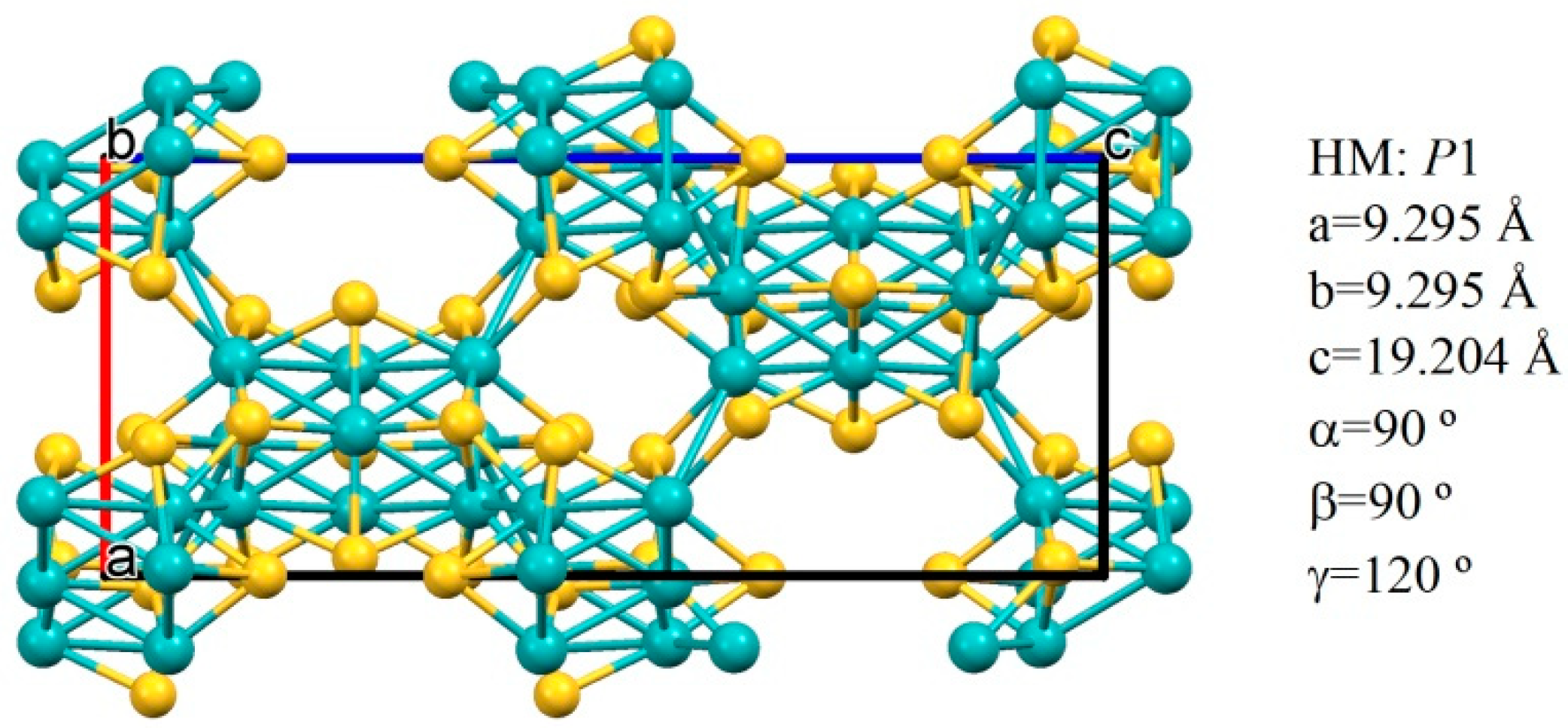
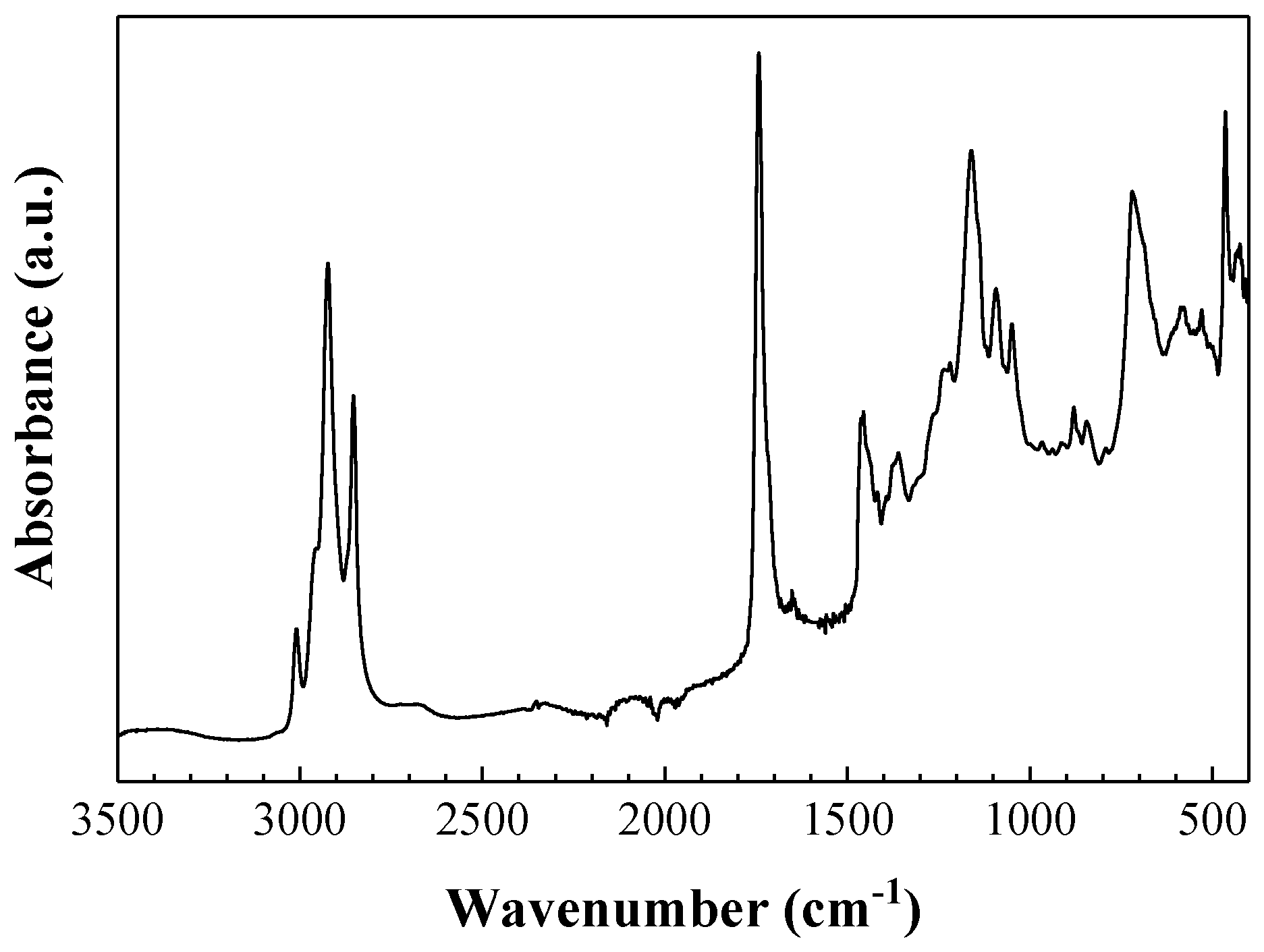
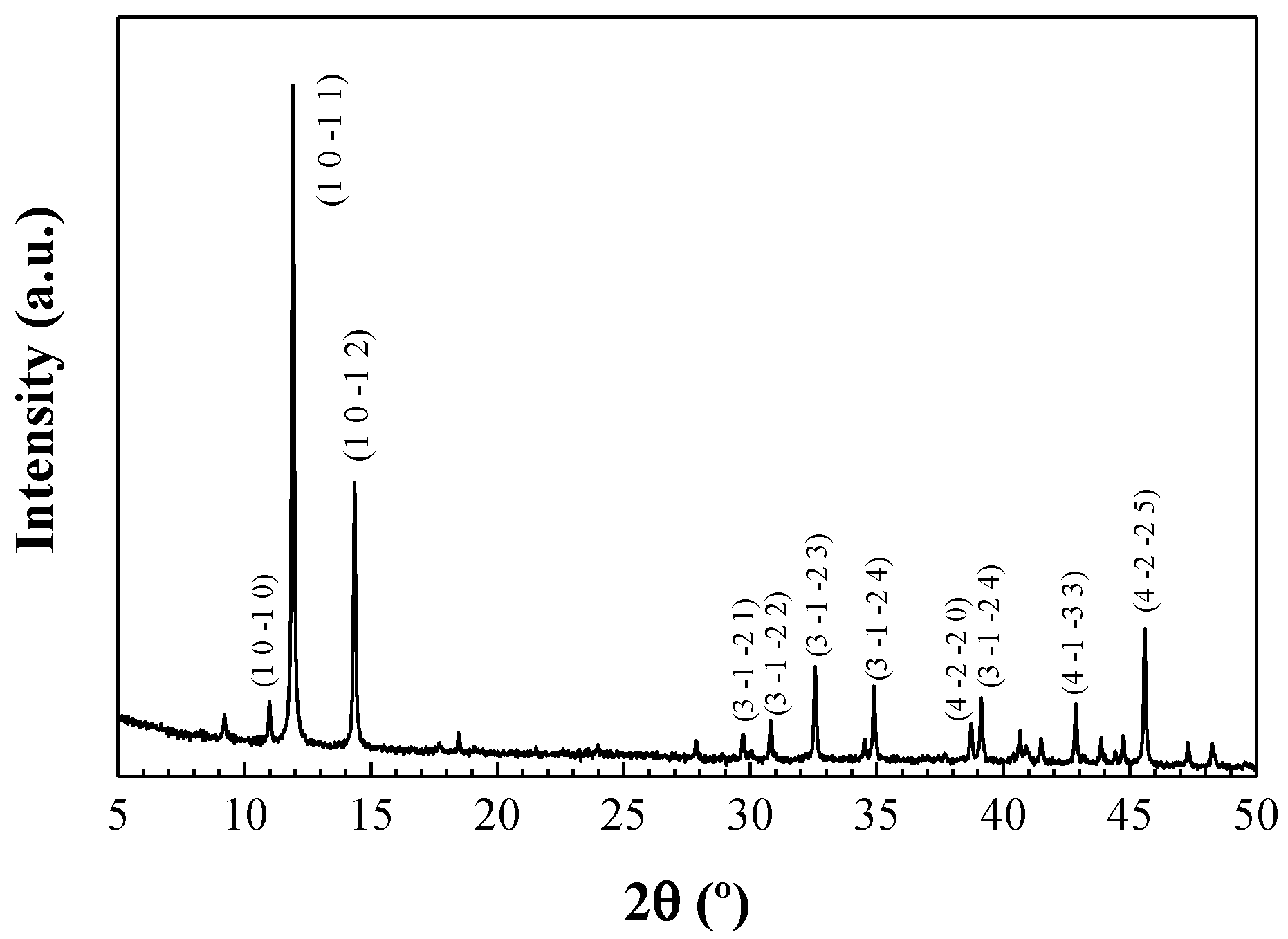
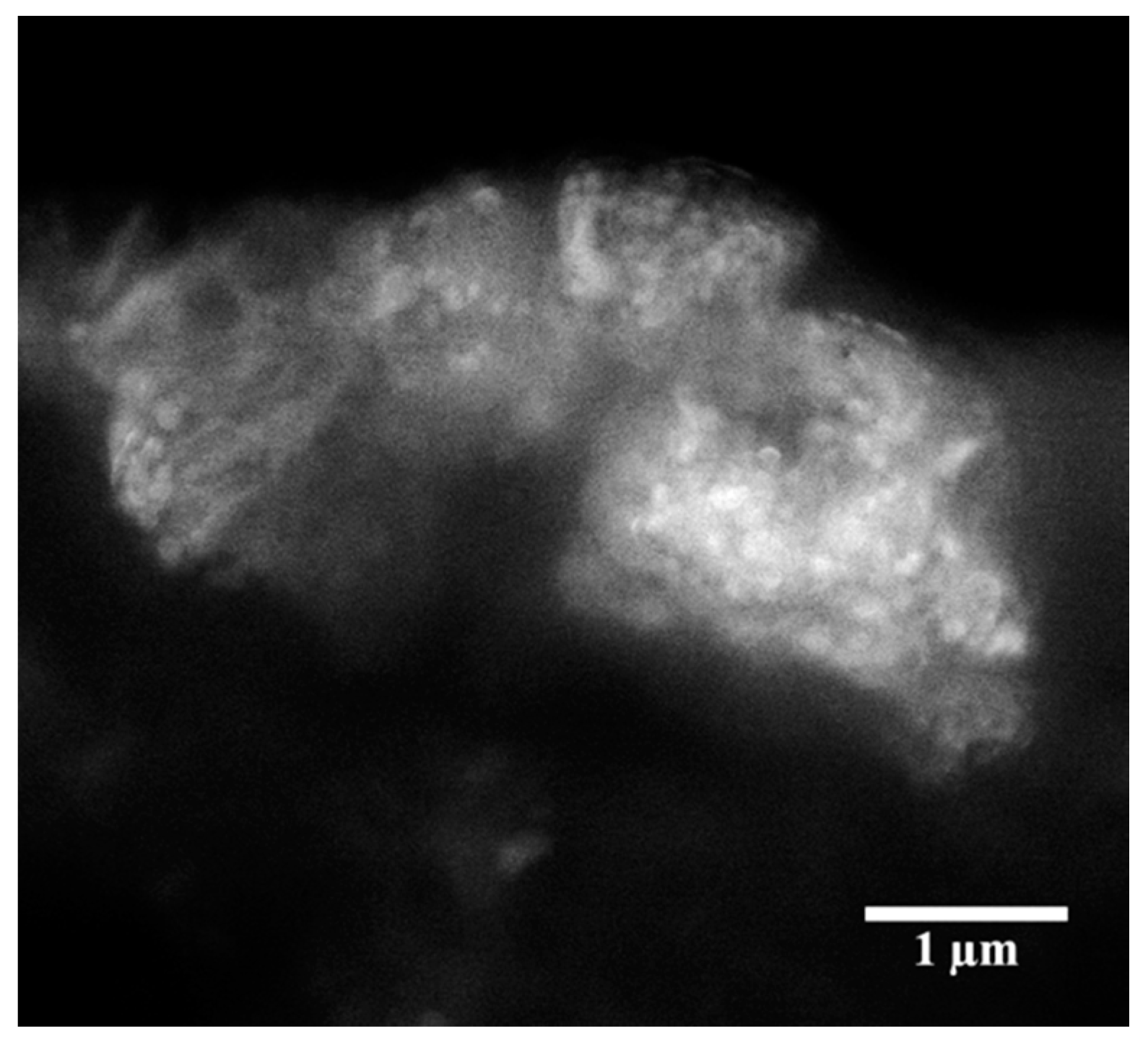
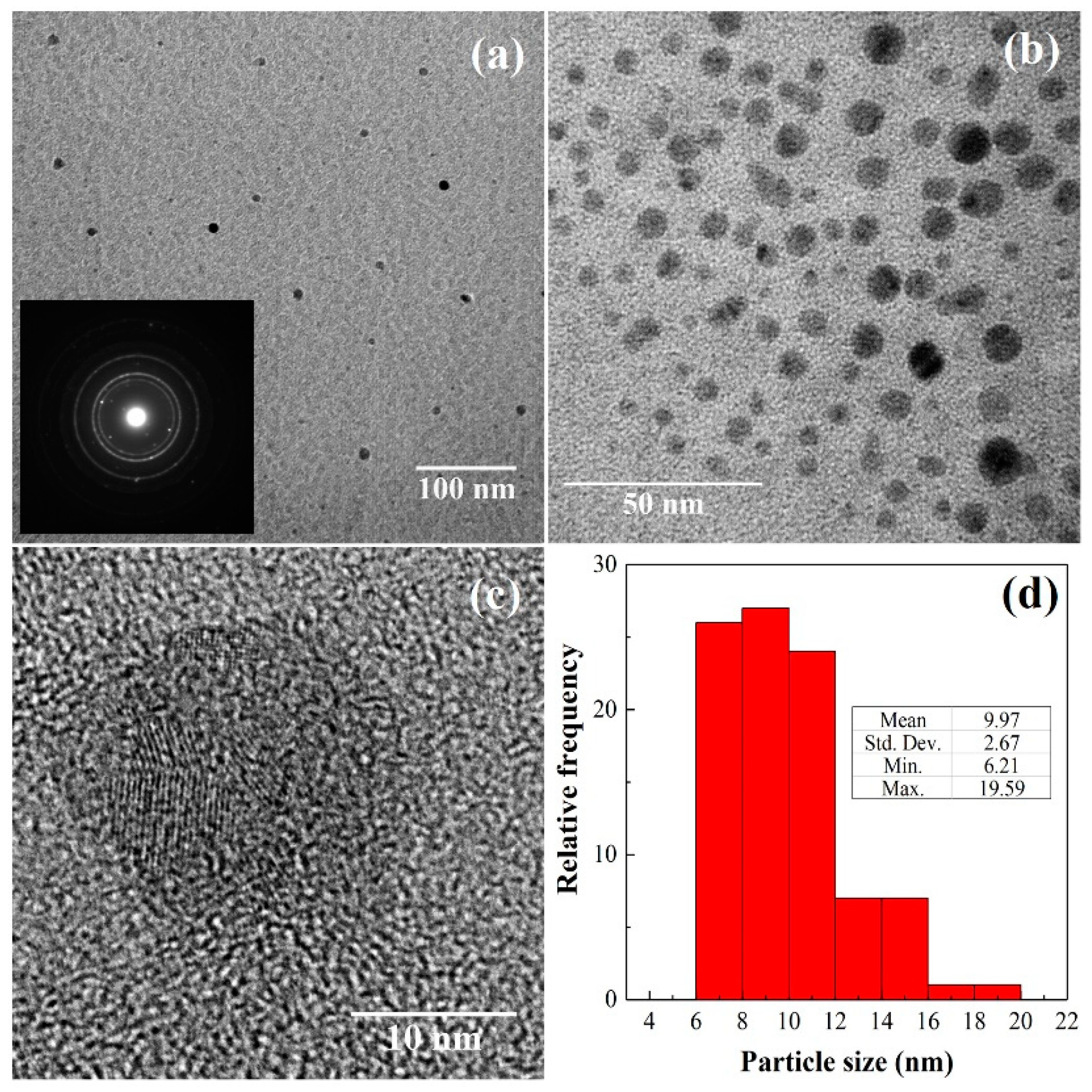
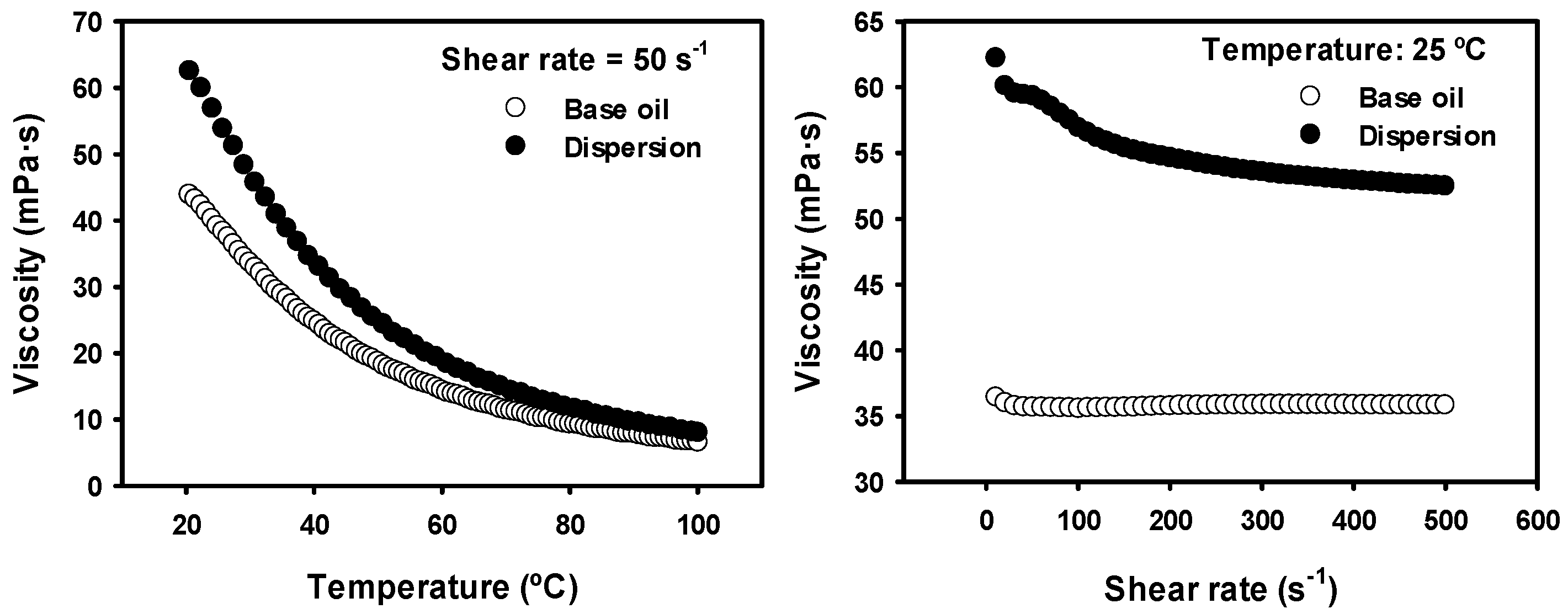
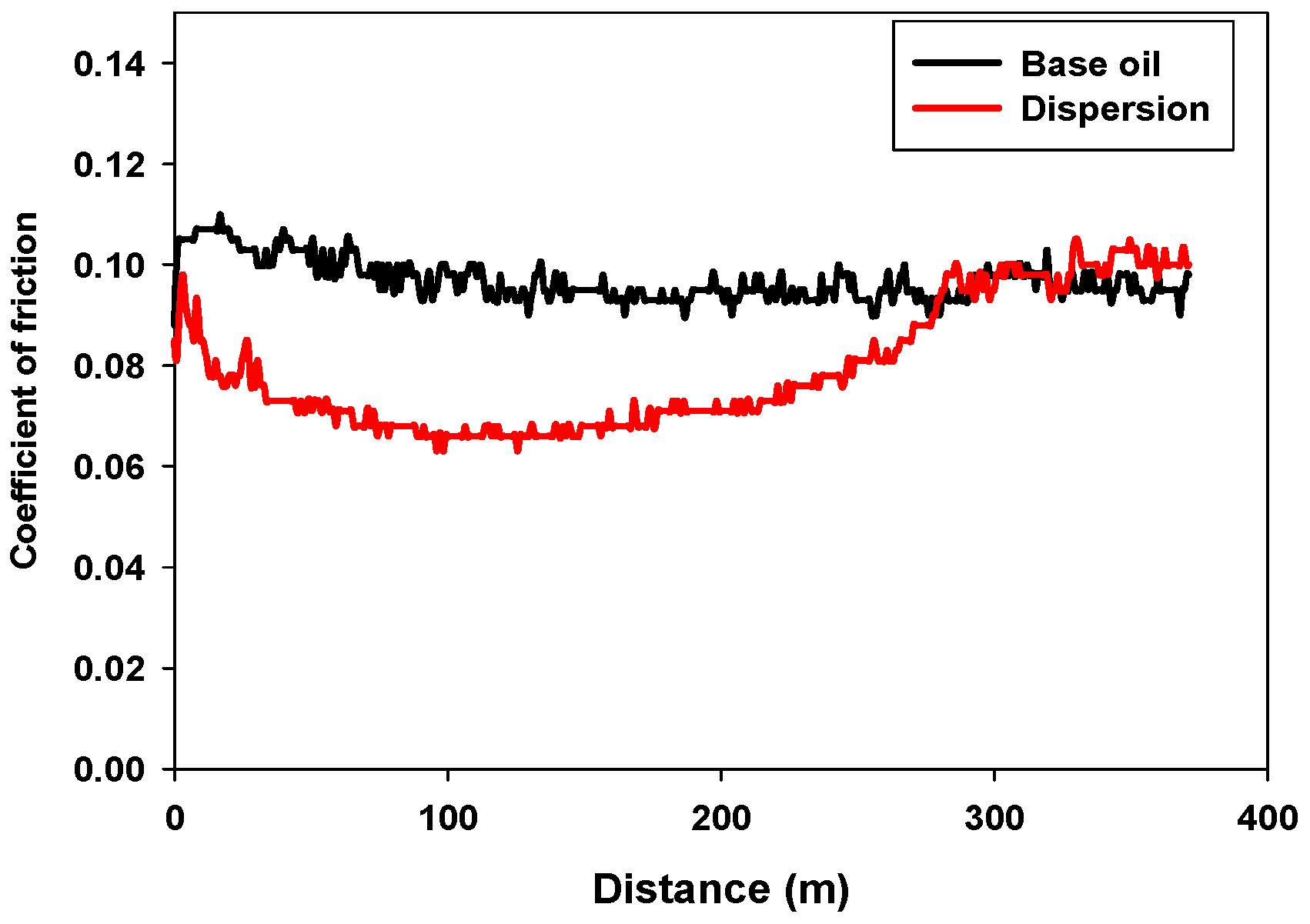

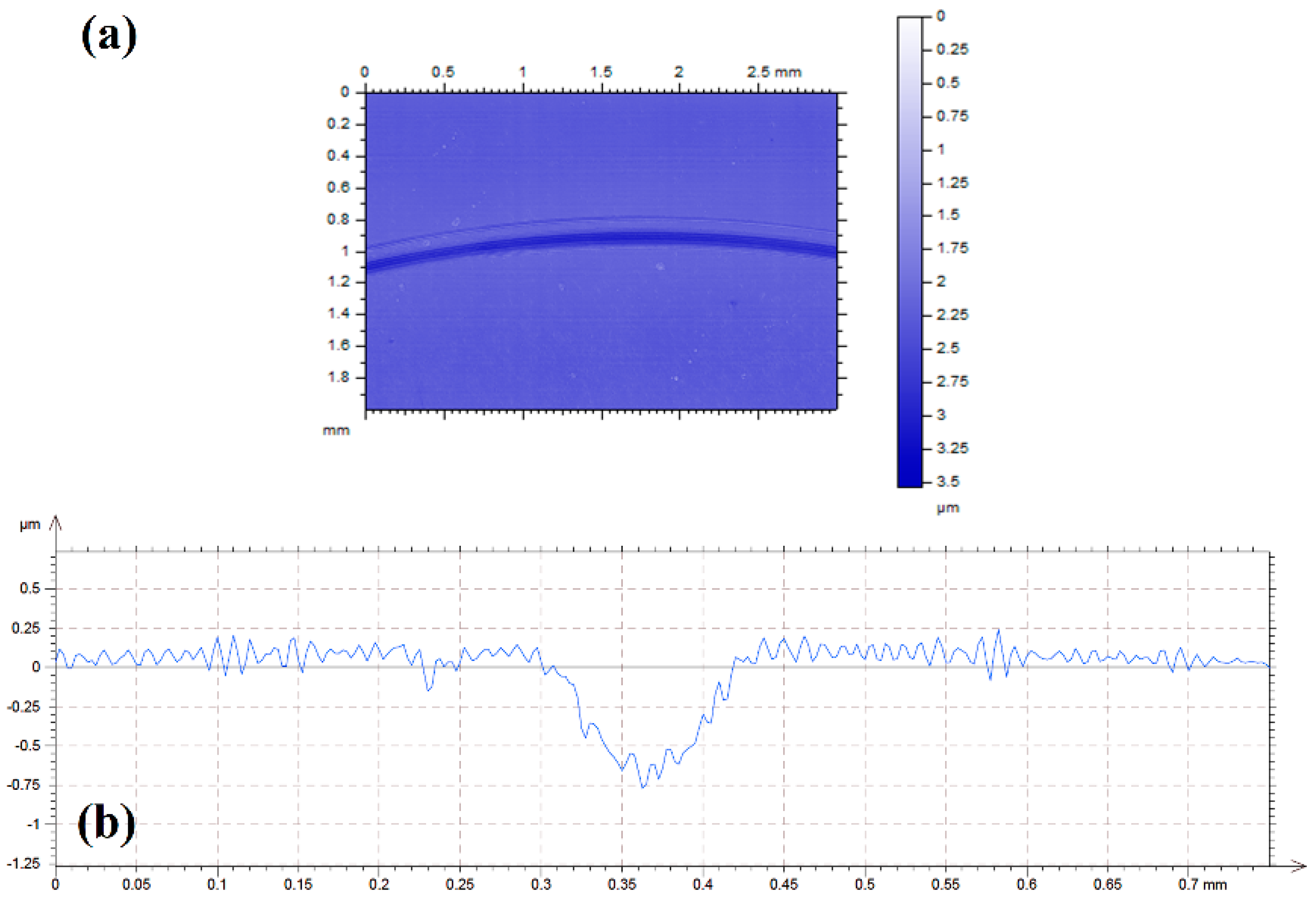



| Lubricant: Base Oil | Coefficient of Friction |
| Test 1 | 0.097 (±0.004) |
| Test 2 | 0.115 (±0.007) |
| Test 3 | 0.109 (±0.003) |
| Average | 0.107 (±0.009) |
| Lubricant: Dispersion | Coefficient of Friction |
| Test 1 | 0.081 (±0.015) |
| Test 2 | 0.079 (±0.013) |
| Test 3 | 0.085 (±0.010) |
| Average | 0.082 (±0.003) |
© 2018 by the authors. Licensee MDPI, Basel, Switzerland. This article is an open access article distributed under the terms and conditions of the Creative Commons Attribution (CC BY) license (http://creativecommons.org/licenses/by/4.0/).
Share and Cite
Fernández-Coppel, I.A.; Martín-Ramos, P.; Martín-Gil, J.; Pamies, R.; Avella, M.; Avilés, M.D. Synthesis and Exploration of the Lubricating Behavior of Nanoparticulated Mo15S19 in Linseed Oil. Materials 2018, 11, 1783. https://doi.org/10.3390/ma11091783
Fernández-Coppel IA, Martín-Ramos P, Martín-Gil J, Pamies R, Avella M, Avilés MD. Synthesis and Exploration of the Lubricating Behavior of Nanoparticulated Mo15S19 in Linseed Oil. Materials. 2018; 11(9):1783. https://doi.org/10.3390/ma11091783
Chicago/Turabian StyleFernández-Coppel, Ignacio A., Pablo Martín-Ramos, Jesús Martín-Gil, Ramón Pamies, Manuel Avella, and María Dolores Avilés. 2018. "Synthesis and Exploration of the Lubricating Behavior of Nanoparticulated Mo15S19 in Linseed Oil" Materials 11, no. 9: 1783. https://doi.org/10.3390/ma11091783
APA StyleFernández-Coppel, I. A., Martín-Ramos, P., Martín-Gil, J., Pamies, R., Avella, M., & Avilés, M. D. (2018). Synthesis and Exploration of the Lubricating Behavior of Nanoparticulated Mo15S19 in Linseed Oil. Materials, 11(9), 1783. https://doi.org/10.3390/ma11091783









